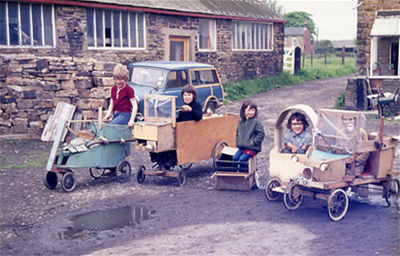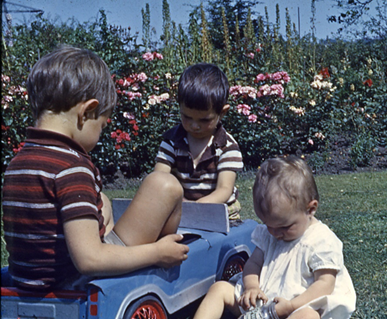40 Years with IAM RoadSmart
By Richard Gentle
I couldn’t help but notice a striking change on my membership card this year – member for 40 years! How that time has flown by.
I’ve always been interested in cars and driving from a young age. I had my first lesson shortly after my 17th birthday, charged with a promise to three friends about a concert in Manchester.
The day I passed my test was also the day I took those three friends on that promised journey. I drove us over Yorkshire’s steep and winding Woodhead Pass to Manchester to see Al Stewart in concert.
As I started out on my journey to collect them, I glanced at the empty passenger seat of my mother’s Mini saloon and realised for the first time, I was on my own and completely responsible for my driving. The Woodhead Pass was without lighting and the torrential rain an additional challenge – but I drove safely, and the trip was a success.
People often say that you begin to learn to drive after you’ve passed your test. The same goes for passing the Advanced test, as I did at age 20. Since that time, although there’ve been a couple of times where I’ve felt like I’ve let myself down, the important thing I would share with others is this: Unlike being a regular driver, an Advanced driver generally knows what they should be doing in any situation and the additional skills learnt through the advanced training have certainly rubbed off on my general driving abilities. So even if I’m not always one of those ‘perfect’ drivers, I’m always more aware than I would have been, had I not undergone the advanced training with IAM RoadSmart.

Richard second from left driving his Charabanc age 13 (made when age 11)
The things I’ve noticed over the last 40 years on the roads is just how much more congestion there is. Weekends are as busy as weekdays. Looking well ahead is more important now, than it has ever been. There’s rarely a time now when you’re the only car on the road.
The traditional 'rush hour' at each end of the normal working day, starts much earlier and lasts around 2½ hours making it rush hours!
I’ve also noticed that driver safety and observation need improving on motorways. An increasing number of drivers seem to abruptly change lanes on motorways when they see other vehicles approaching the slip road at junctions. As an advanced driver it’s easy to see they are not planning ahead or behind. I ask myself, have they checked to see what is approaching them from behind? Are they considering their rash movements and its impact on other drivers?
While the driver already on the motorway still has priority and if necessary, the driver entering from the left may have to adapt their speed to join seamlessly, or even stop to give way.
Roads generally are already operating beyond their originally intended capacity.
My top tips I’d give to my younger self:
• Look as far ahead as you can - remember the view under vehicles too.
• Develop the feeling for anticipating what other road users are going to do.
• Always indicate your intentions clearly and correctly.
• Always leave space to react - ahead and behind.
• Always drive within your capabilities and the vehicle you are driving, so you always have a safety margin to use if something unexpected happens.
• Always turn your head to check the blind spot before pulling out or overtaking.
• Use lights correctly. It's not just about you being able to see - others must be able to see you.
• If you must use rear fog lights, turn them off once another driver is close enough to you, to see your normal lights.
• 'Look once, look twice, think bike!' (I think we should reintroduce public information driving safety adverts on TV, like we had in the 70s).
A few things I’ve learnt along the way:
1. Looking ahead as far as it's possible to see; using distance as a vantage point to see where the road is going and what potential obstacles, pedestrians, horse riders, cyclists and other traffic might be visible, before reaching that section of road.
2. Looking at the visible view ahead, under vehicles e.g., on brows of hills, as well as leaving distance to look around them.
3. Anticipating the likely actions of other road users and pedestrians - preparing to slow down in advance and then giving plenty of room - particularly when passing cyclists, horse riders and parked vehicles.
4. Not making manual gear changes in the middle of junctions, after being first in line to leave traffic lights.
5. Always indicate intentions at, and on, roundabouts, whenever other motorists would benefit from knowing precisely, your route intentions. (In my experience, even the IAM had different views on this).
6. Always be aware of what is behind you and when stopping in a queue of traffic, leave enough room in front between yourself and the next vehicle so that you have somewhere to go if someone approaches you a bit fast from behind and then needs additional braking distance that you can quickly give them. At the same time, if a vehicle breaks down in front of you, there is room for you to turn out without having to reverse.
7. If you see traffic has stopped for roadworks just ahead of a blind bend, leaving only room for a couple more vehicles, hold back just before the bend so approaching traffic knows there is potentially hidden stationary traffic ahead and only move ahead once other cars are behind you - and remember item 6 above. (There have been many times when temporary roadworks has followed legislation, rather than common sense, and signs have not been adjusted to take account of increased traffic approaching roadworks en masse at busy times and road work signs are not visible until after blind bends, some distance from the roadworks.
8. If the road ahead has a build-up of slow traffic, and looking ahead it seems clear to overtake, as nothing is approaching, be aware that someone a few vehicles ahead might be about to turn right.

From all that I’ve learnt over the last 40 years, I would always recommend that anyone with an interest in their driving ability and skills should undertake the IAM RoadSmart Advanced Driver Training. You quickly pick up useful information from skilled practitioners and develop roadcraft skills, beyond the regular test, which remain with you for life. Secondary benefits can include being looked on favourably when applying for work requiring job-related driving, and in some instances, lower vehicle insurance premiums.

